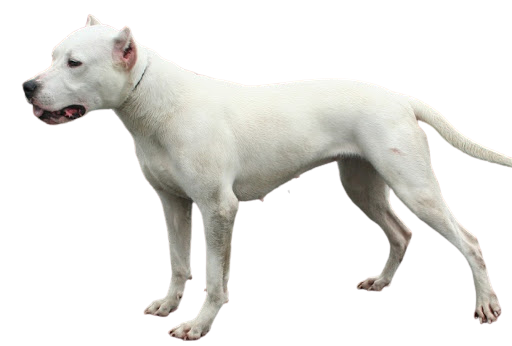
Cordoba Fighting Dog
Unavailable Price Avg.
Extinct
Group
Cross Breed
Breed Type
Large
Size
10-12 years
Lifespan
Breed Information
| Group | Extinct |
|---|---|
| Popularity/Rank | 253 |
| Origin | Argentina |
| Other Names | Argentine Fighting Dog, Cordoban Fighting Dog, Cordobese dog, Fighting Dog of Cordoba, Perro de Pelea Cordobés, Perro de Presa de Cordoba |
| Breed Type | Cross Breed |
| Price (Avg.) | Unavailable |
| Size | Large |
| Weight |
Male: 55-90 pounds (25-41 kg),
Female: 45-85 pounds (20-39 kg) |
| Height |
Male: 22-26 inches (56-66 cm),
Female: 20-24 inches (51-61 cm) |
| Lifespan | 10-12 years |
| Recognized by |
Not recognized by the American Kennel Club. And Not recognized by FCI. |
| Purpose | Protection |
| Date of Origin | 1872 |
| Ancestry | Spanish |
Appearance & Maintenance
| Coat | Dense, Smooth |
|---|---|
| Coat Colors | White |
| Grooming Level | |
| Shedding Level | |
| Eye Color Possibilities | Hazel, Brown, Amber, Black |
| Nose Color Possibilities | Black, Brown, Liver, Red, Tan |
| Coat Color Possibilities | Fawn, Brindle, Red, White, Black, Tan |
| Coat Length | Medium |
| Coat Density | Medium |
| Coat Texture | Short and smooth |
| Recommended Brushes | Slicker brush, pin brush, shedding blade, comb, mat rake, undercoat rake. |
| Brushing Frequency | Once a week |
Breed Characteristics
| Temperament | Aggressive, Fierce, Fighter, Relentless, Strong, Vigorous |
|---|---|
| Intelligent | |
| Trainability | |
| Playfulness | |
| Sensitivity Level | |
| Affection Level | |
| Social Interaction Required | |
| Barking | |
| Watchdog Ability | |
| Territorial | |
| Biting Force | Moderate |
| Mouthiness | |
| Impulse to Wander or Roam | |
| Prey Drive | |
| Adaptability | |
| Tolerates Being Left Alone | |
| Fighting Dog | Yes |
Good & Friendly with
| Apartment Life Friendly | |
|---|---|
| Stranger Friendly | |
| Kid-Friendly | |
| Cat Friendly | |
| Dog Friendly | |
| Office Friendly | No |
| Senior Citizens Friendly | |
| Pet Friendly | |
| Friendly with First Time Owners | No |
| Service Dog | Not really |
| Therapy Dog | Not really |
| Detection, Sniffer or Security Dog | Not really |
| Search and Rescue Dog (SAR) | Not really |
| Boat Dog | Not really |
| Cart Pulling or Drafting Dog | Not really |
Health Elements
| Health Issues | |
|---|---|
| Hypoallergenic | No |
| Energy Level | |
| Exercise Required | |
| Sleeping Required | |
| Weight Gain Potential | |
| Weather & Climate | Prefers warm weather |
| Stinkiness | Medium |
| Drooling tendency | |
| Activity Level | High |
| Rec. Walk Mileage Per Week | 30 miles |
| Minutes of Activity Per Day | 30-60 minutes |
Food & Costing
| Avg. Daily Food | 2.5 to 4 cups of high-quality dry food a day, divided into two meals. |
|---|---|
| Cups Per Day | 3/4 cup |
| Daily Cost | $10-$20 |
| Monthly Cost | $50-$100 |
Reproducibility
| Gestation Duration | 60-64 days |
|---|---|
| How often can the Cordoba Fighting Dog have a litter? | Once a year. |
| Litter Size | 2-8 puppies (Once a year.) |
Description
The Cordoba Fighting Dog is a large, muscular breed of dog that originated in Argentina. It is a cross between the Bulldog and the Boxer, and it has become popular in recent years due to its loyal and protective nature. The Cordoba Fighting Dog has a strong, athletic build with a broad chest and powerful legs. Its coat is short and dense, usually white or cream-colored with patches of black or brown.
The average lifespan of the Cordoba Fighting Dog is 10 to 12 years. They typically weigh between 50 to 70 pounds and stand at an average height of 22 to 24 inches tall at the shoulder. The breed comes in several colors including white, black, brown, brindle, fawn, red-brown and tan.
The personality of the Cordoba Fighting Dog is loyal and protective towards its family members but can be aggressive towards strangers if not properly socialized from an early age. They are intelligent dogs that are eager to please their owners but can be stubborn at times if not given proper training or guidance.
Cordoba Fighting Dogs are generally friendly with other dogs as long as they have been properly socialized from an early age; however they may be aggressive towards strange dogs if not trained properly or given enough exercise on a regular basis. They tend to get along well with children when raised together but may be too energetic for small children due to their size and strength so supervision should always be present when around young kids. The breed also tends to get along well with other animals such as cats if raised together from puppyhood; however they may still chase after smaller animals such as rodents due to their hunting instincts so caution should still be taken when introducing them into homes with other pets present.
The temperament of the Cordoba Fighting Dog is alert yet gentle; they make excellent guard dogs due to their loyalty towards their family members but can also make great companions for those looking for an active pet that loves spending time outdoors playing fetch or going on walks/runs/hikes etc..
The health of the Cordoba Fighting Dog is generally good although some individuals may suffer from hip dysplasia which can cause lameness in one or both hind legs; this condition can usually be managed through diet changes or medication prescribed by your veterinarian depending on severity levels so it’s important that you keep up regular checkups for your pet’s health throughout its life span .
The adaptability level of the Cordoba Fighting Dog is high; they do best in homes where there are plenty of activities available for them such as long walks/runs/hikes etc., however they do need plenty of space indoors too since these dogs love being around people so much! This breed does best in homes where there are no small children present since these large dogs could easily knock over toddlers while playing without meaning any harm – supervision should always be present when around young kids regardless!
Overall, owning a Cordoba Fighting Dog can bring many benefits into your life such as loyalty & protection while also providing you with an active companion who loves spending time outdoors playing fetch & going on adventures! These intelligent & loving creatures make great guard dogs while also being gentle enough around children & other animals making them perfect additions into any home looking for an all-around great pet!
History
The Cordoba Fighting Dog is a breed of dog that originates from the city of Cordoba in Argentina. The breed is also known as the Cordoban Fighting Dog, the Argentinean Fighting Dog, and the Cordovan Dog. The Cordoba Fighting Dog was used for dog fighting and bull-baiting in its native country of Argentina. The breed was also used as a guard dog and a hunting dog. The Cordoba Fighting Dog is a large breed of dog that can weigh up to 100 pounds. The height of the Cordoba Fighting Dog varies from 24 inches to 28 inches. The coat of the Cordoba Fighting Dog is short and smooth. The coat colors of the Cordoba Fighting Dog include black, brindle, fawn, and white.
The history of the Cordoba Fighting Dog breed can be traced back to the 16th century when Spanish conquistadors arrived in South America. The Spanish conquistadors brought with them a number of different breeds of dogs, including mastiffs, bulldogs, and terriers. These dogs were bred with local dogs to create a new type of fighting dog that was better suited for the climate and terrain of South America. This new type of fighting dog became known as the Cordoba Fighting Dog.
The Cordoba Fighting Dog became popular in Argentina during the 19th century.Dog fighting was a popular sport in Argentina during this time period. The popularity of the CordobaFightingDog increased even further when an Argentinean doctor named Antonio Nores Martinez began breeding them for bull-baiting. Bull-baiting is a blood sport in which bulls are pitted against dogs for entertainment purposes.
The ancestryoftheCordobafightingdog includes several different breedsofdogs such as mastiffs, bulldogs, terriers, and poodles. From these different breeds, only those dogs that had certain physical characteristics and temperament were selected to be bred with each other in order to create cordobafightingdogs that met specific standards set by Dr Martinez .
TheCordobafightingdogbreedwas officially recognized bythe Argentine Kennel Club in 1940s . In orderto keepthebreedfrom becoming extinct , Dr Martinez gave someof his cordobafightingdogsto friendsand family members who agreedto continuebreedingthem .
Today , there are only a few hundredCordobafightingdogsin existence . However , due tothe efforts of dedicated breeders , this numberis slowly but surely increasing . Thanks to these dedicated breeders , future generations will be ableto enjoythis uniqueand fascinatingbreedofdog .


